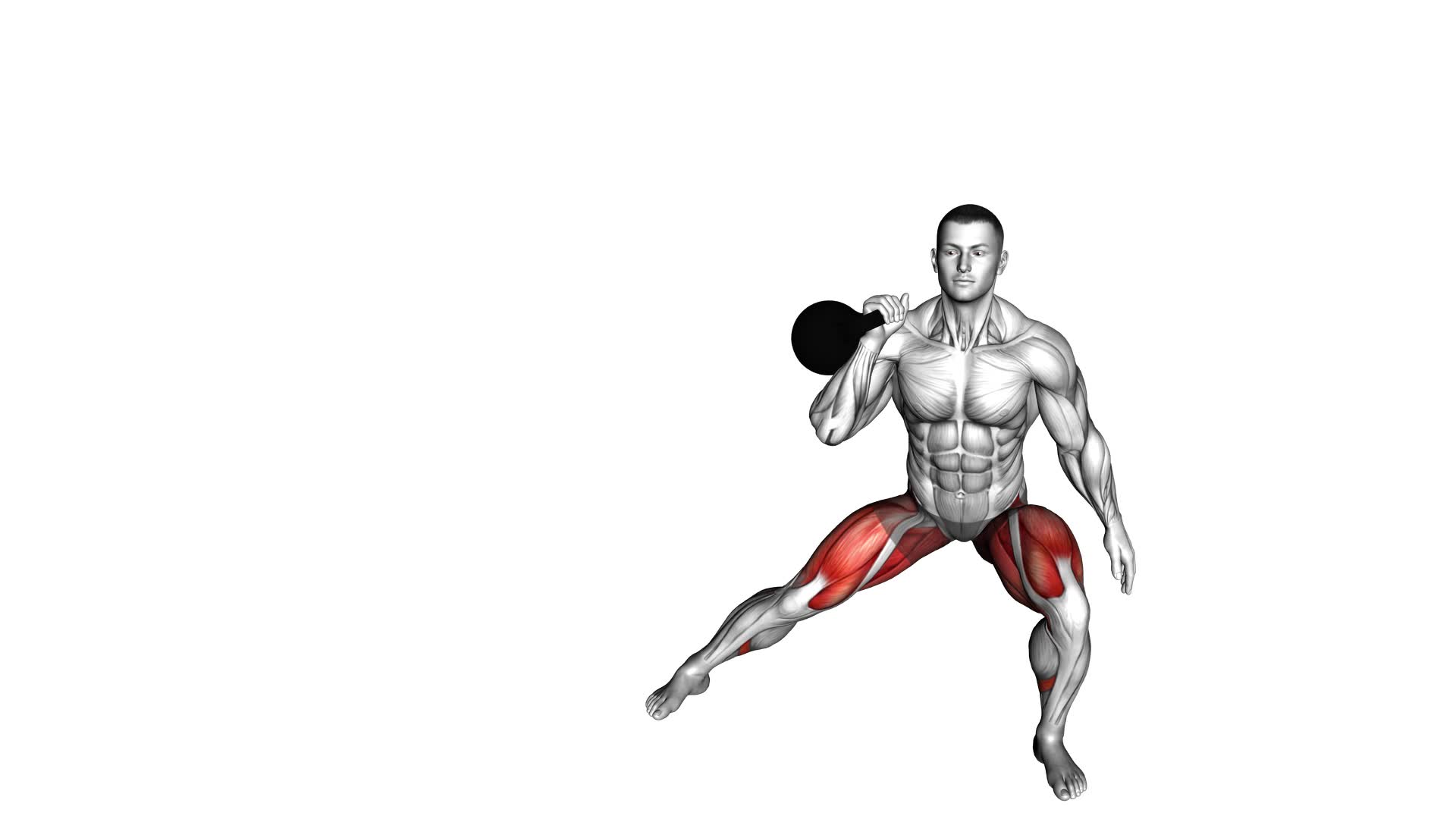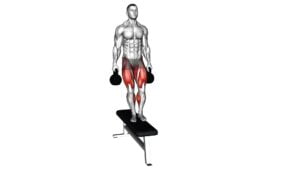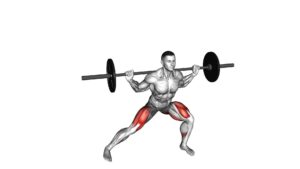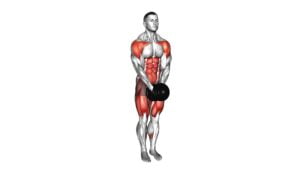Kettlebell Lateral Lunge – Video Exercise Guide & Tips

Are you looking to add a new exercise to your routine that targets multiple muscle groups?
Watch This Exercise Video
Look no further than the kettlebell lateral lunge. This dynamic exercise helps to strengthen your legs, glutes, and core while also improving your balance and stability.
In this article, we will guide you through proper form and technique, offer variations to challenge yourself, and provide tips for a more effective workout.
Get ready to take your fitness to the next level with the kettlebell lateral lunge.
Key Takeaways
- The kettlebell lateral lunge targets multiple muscle groups and strengthens legs, glutes, and core.
- Proper form and technique are crucial for this exercise, including maintaining balance and weight on heels and focusing on proper form and technique.
- There are variations of the kettlebell lateral lunge that can challenge yourself and target specific muscle groups.
- Injury prevention techniques such as warming up, maintaining proper form, engaging the core, and incorporating dynamic stretches are important for a safe and effective workout.
Benefits of the Kettlebell Lateral Lunge
To maximize your workout, incorporate the kettlebell lateral lunge for its strengthening and toning benefits. This exercise not only targets your lower body muscles but also aids in preventing injuries and activating multiple muscle groups.
The kettlebell lateral lunge primarily works your glutes, quadriceps, hamstrings, and adductors. By engaging these muscles, you can improve your overall lower body strength and stability. This exercise also helps to develop better balance and coordination.
Additionally, the kettlebell lateral lunge activates your core muscles, including the abdominals and obliques. This not only strengthens your midsection but also enhances your posture and stability during other exercises or daily activities.
By incorporating the kettlebell lateral lunge into your workouts, you can also improve your hip mobility and flexibility. This exercise requires a wide range of motion in the hips, helping to prevent injuries such as strains or pulls.
To perform the kettlebell lateral lunge correctly, start by standing with your feet shoulder-width apart, holding a kettlebell with both hands in front of your chest. Take a big step to the side, keeping your chest up and back straight, and lower your body into a lunge position. Push through your heel to return to the starting position, then repeat on the other side.
Remember to start with a lighter weight and gradually increase the load as you become more comfortable and confident with the movement. Always maintain proper form and listen to your body's limits to ensure a safe and effective workout.
Proper Form and Technique
Maintain proper form and technique while performing the kettlebell lateral lunge to maximize its effectiveness and minimize the risk of injury. Here are three key points to keep in mind:
- Start with the correct stance:
- Stand with your feet shoulder-width apart and hold the kettlebell in front of your chest with both hands.
- Keep your back straight and engage your core muscles to maintain stability throughout the exercise.
- Take a lateral step:
- Take a big step to the side with your right foot, keeping your left foot planted on the ground.
- Bend your right knee and lower your body towards the ground, while keeping your left leg straight.
- Make sure to keep your weight on your heels and maintain proper balance.
- Push off and repeat:
- Push off with your right foot and return to the starting position.
- Repeat the movement on the other side by stepping to the left.
- Remember to maintain proper form and technique throughout the exercise to prevent injury and maximize the effectiveness of your workout.
Variations to Challenge Yourself
Challenge yourself with different variations of the kettlebell lateral lunge to intensify your workout and target specific muscle groups. By incorporating variations and advanced techniques into your routine, you can add an extra level of difficulty and maximize the benefits of this exercise.
One variation you can try is the kettlebell overhead lateral lunge. Start by holding a kettlebell overhead with one hand, keeping your arm fully extended. As you lunge to the side, lower the kettlebell towards the opposite foot, maintaining control and stability. This variation not only works your legs and glutes but also engages your core and shoulder muscles.
Another challenging variation is the kettlebell lateral lunge with a rotation. Hold the kettlebell with both hands in front of your chest. As you lunge to the side, rotate your torso towards the same side, extending your arms and kettlebell outwards. This variation adds an element of rotational strength and stability to the exercise.
To further challenge yourself, you can also try performing the kettlebell lateral lunge on an unstable surface, such as a Bosu ball or a balance board. This forces your muscles to work harder to maintain balance and stability throughout the movement.
Incorporating these variations and advanced techniques into your kettlebell lateral lunge routine won't only keep your workouts interesting but also help you target different muscle groups and improve overall strength and stability. Remember to start with lighter weights and gradually increase the intensity as you become more comfortable with each variation.
Common Mistakes to Avoid
When performing the kettlebell lateral lunge, it's important to maintain proper form to maximize the effectiveness of the exercise and prevent injury. This includes keeping your back straight, engaging your core, and ensuring that your knees stay aligned with your toes.
Proper Form Demonstration
To achieve proper form during the kettlebell lateral lunge exercise, focus on maintaining a stable core and avoiding these common mistakes:
- Leaning Forward: Keep your chest up and shoulders back throughout the movement. Avoid hunching over or rounding your back, as this can strain your lower back and compromise your form.
- Collapsing Knee: As you lunge to the side, make sure to keep your knee in line with your toes. Avoid letting your knee collapse inward, as this can put unnecessary stress on your knee joint and increase the risk of injury.
- Neglecting the Hips: Engage your glutes and hips as you push back up from the lunge. This helps to stabilize your body and generate power for the movement. Neglecting to activate these muscles can result in a weaker and less effective exercise.
Injury Prevention Techniques
To prevent injuries, focus on avoiding common mistakes while performing the kettlebell lateral lunge exercise. Injury prevention strategies are crucial to ensure a safe and effective workout.
One of the most important techniques is to always warm up before starting any exercise routine. A proper warm up prepares your muscles for the physical demands of the exercise and reduces the risk of injury. Incorporate dynamic stretches and movements that mimic the kettlebell lateral lunge to warm up your lower body muscles.
Additionally, it's essential to maintain proper form throughout the exercise. Avoid leaning forward excessively or rounding your back, as this can strain your lower back and lead to injury. Engage your core and keep your chest up to maintain a neutral spine position.
Tips for a More Effective Workout
Maximize your workout efficiency with these helpful tips:
- Gradual Progression: To avoid injury and ensure long-term success, it's important to progress gradually when incorporating the kettlebell lateral lunge into your workout routine. Start with lighter weights and focus on mastering proper form before increasing the intensity.
- Proper Technique: Executing the kettlebell lateral lunge with proper form is crucial for an effective workout. Maintain a straight back, engage your core, and keep your knees aligned with your toes. This will help target the desired muscles and minimize the risk of injury.
- Warm-Up and Cool Down: Prior to starting your workout, warm up your body with dynamic stretches and light cardio exercises. This will increase blood flow to your muscles and prepare your body for the workout. Afterward, cool down with static stretches to prevent muscle soreness and aid in recovery.
By following these progression tips, injury prevention techniques, and incorporating a warm-up and cool down routine, you can make your kettlebell lateral lunge workout more effective.
Now, let's move on to the next section, where we'll discuss precautions and modifications for beginners.
Precautions and Modifications for Beginners
Before starting the kettlebell lateral lunge, it's important to focus on proper form. Keep your back straight, engage your core, and make sure to maintain balance throughout the movement.
As a beginner, it's recommended to start with lighter weights and gradually increase the load as you build strength and confidence.
Additionally, consider modifications such as using a resistance band or performing the exercise without weights to ensure safety and prevent any potential injuries.
Proper Form Tips
Ensure proper alignment and stability during the kettlebell lateral lunge to minimize risk and maximize effectiveness. Here are some tips to help you maintain proper form and prevent injury:
- Keep your chest up and shoulders back throughout the movement. This will help you maintain a neutral spine and prevent excessive forward leaning.
- Engage your core muscles by drawing your navel towards your spine. This will provide stability and support to your lower back.
- Step out to the side with your foot, keeping your knee aligned with your toes. Avoid allowing your knee to collapse inward, as this can put stress on the joint.
Gradual Progression Suggestions
To gradually progress in your kettlebell lateral lunge, beginners should focus on using lighter weights and implementing modifications for increased safety and effectiveness. Start with a kettlebell that you can easily handle and gradually increase the weight as you become more comfortable with the movement.
As you progress, you can also try adding more repetitions or sets to your workout. Another modification to consider is performing the exercise without any weights at all, focusing solely on the movement and form. This can help build strength and stability before moving on to more advanced techniques.
By gradually increasing the intensity and difficulty of your kettlebell lateral lunge, you can ensure steady progress and minimize the risk of injury.
Now, let's discuss some safety considerations for modifications.
Safety Considerations for Modifications
When modifying the kettlebell lateral lunge for beginners, prioritize safety and effectiveness by using lighter weights and making adjustments to accommodate your current fitness level. Here are some safety considerations and modifications to keep in mind:
- Injury prevention: Start with a thorough warm-up to increase blood flow to your muscles and prepare your body for exercise. Include dynamic stretches and mobility exercises that target the muscles you'll be using during the lateral lunge.
- Lighter weights: Choose a kettlebell that allows you to maintain proper form throughout the exercise. If you're struggling to perform the movement with control, reduce the weight or use a dumbbell instead.
- Range of motion: If you have limited mobility or flexibility, you can decrease the depth of your lunge to a comfortable level. Focus on maintaining good posture and engaging the muscles in your legs and hips.
Frequently Asked Questions
How Many Sets and Repetitions Should I Do for the Kettlebell Lateral Lunge?
For the kettlebell lateral lunge, the number of sets and repetitions you should do depends on your fitness level and goals. Generally, it's recommended to start with 2-3 sets of 8-12 repetitions on each leg.
As you progress, you can increase the number of sets or repetitions to challenge yourself further. Additionally, there are variations of the kettlebell lateral lunge that you can incorporate into your routine for added variety and intensity.
Can I Perform the Kettlebell Lateral Lunge Without Using a Kettlebell?
Yes, you can perform the kettlebell lateral lunge without using a kettlebell. There are alternatives and modifications you can try. Instead of holding a kettlebell, you can use a dumbbell, a medicine ball, or even just your body weight.
These variations will still target your legs, glutes, and core muscles. Remember to maintain proper form and technique to get the most out of the exercise.
Is the Kettlebell Lateral Lunge Suitable for People With Knee or Hip Issues?
If you have knee or hip issues, it's important to be cautious when performing the kettlebell lateral lunge. This exercise puts strain on these joints, so modifications may be necessary. Consider using a lighter weight or no weight at all to reduce the impact.
Can I Incorporate the Kettlebell Lateral Lunge Into a Full-Body Workout Routine?
Incorporating the kettlebell lateral lunge into your full-body workout routine can be a great way to target multiple muscle groups and improve your overall strength and stability. This exercise not only works your legs, but also engages your core and glutes.
To add variation to your routine, you can try different kettlebell weights or even perform the lateral lunge with a dumbbell instead. Remember to maintain proper form and start with lighter weights if you're new to this exercise.
How Can I Progress or Make the Kettlebell Lateral Lunge More Challenging Over Time?
To progress the kettlebell lateral lunge and make it more challenging over time, you can try a few things.
First, increase the weight of the kettlebell you use. This will add more resistance and make your muscles work harder.
Next, you can also try increasing the depth of your lunge, going lower as you get stronger.
Lastly, you can add an explosive jump at the end of each lunge to further engage your muscles.
Conclusion
In conclusion, the kettlebell lateral lunge is a beneficial exercise that targets multiple muscles and improves strength, stability, and mobility.
By maintaining proper form and technique, challenging yourself with variations, and avoiding common mistakes, you can maximize the effectiveness of your workout.
Beginners should take precautions and make modifications as needed to ensure safety and prevent injury.
Incorporating the kettlebell lateral lunge into your fitness routine can help you achieve your goals and enhance overall fitness.

Author
Years ago, the spark of my life’s passion ignited in my mind the moment I stepped into the local gym for the first time. The inaugural bead of perspiration, the initial endeavor, the very first surge of endorphins, and a sense of pride that washed over me post-workout marked the beginning of my deep-seated interest in strength sports, fitness, and sports nutrition. This very curiosity blossomed rapidly into a profound fascination, propelling me to earn a Master’s degree in Physical Education from the Academy of Physical Education in Krakow, followed by a Sports Manager diploma from the Jagiellonian University. My journey of growth led me to gain more specialized qualifications, such as being a certified personal trainer with a focus on sports dietetics, a lifeguard, and an instructor for wellness and corrective gymnastics. Theoretical knowledge paired seamlessly with practical experience, reinforcing my belief that the transformation of individuals under my guidance was also a reflection of my personal growth. This belief holds true even today. Each day, I strive to push the boundaries and explore new realms. These realms gently elevate me to greater heights. The unique combination of passion for my field and the continuous quest for growth fuels my drive to break new ground.







